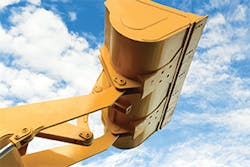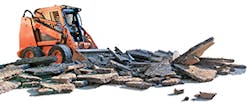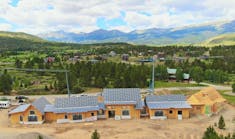Loaders might be unassuming pieces of heavy machinery, and it may have never crossed your mind to consider their importance. But what would any job site be like without these adaptable agents of agile action? Could any construction site really function without a loader on hand?
Loaders are an essential part of most construction managers’ equipment portfolios. Loaders shine on any job site for their versatility, comparatively compact size, and workhorse abilities.
Loaders have been a part of the construction industry since the emergence of heavy machinery when many inventions were made to aid the growing US agriculture industry as cities—and thus, populations—grew and more food was required to sustain them.
The history of loaders stretches back to the 1950s when the first loader attachments were made for farming tractors. On August 2, 1950, Wayne-Roy Corp. filed a patent for a power-operated shovel that attached to a tractor, according to the US Patent and Trademark Office. The loader came with a bucket that an operator used to scoop out dirt and rocks. The invention was an early version of a backhoe loader, which is now used in urban engineering and on smaller or tighter construction projects.
Companies such as Case and JCB soon introduced their own backhoe loaders, and the industry took off, putting the power of heavy excavation out into the market.
Similarly, the skid-steer loader got its start in 1957, when inventors Cyril and Louis Keller created the “Keller loader” to help a Minnesota farmer clean out the droppings from his turkey farm faster than shoveling, according to Marty Padget, an author and automotive journalist who chronicled the history of the skid-steer loader in Bobcat: Fifty Years. Companies eventually approached the Kellers to buy the design and marketed the first commercial skin steer loaders.
Other loaders followed suit or were being developed at about the same time period as more farmers and laborers saw their peers were desperate for innovation that could make everyday blue-collar work faster, simpler, and easier on their breaking bodies.
“The Bobcat skid-steer loader arose from the need for a new kind of machine, one that would facilitate this change by making manual labor easier. It would free workers to be more efficient, turning the power of one man into the power of many. In doing so, it would change the face of a nation,” writes Padget.
Today, the types of available loaders stretch far beyond these offerings. Types of loaders now include a range of options—everything from mini loaders, wheel loaders versus track loaders, front-end loaders, skid-steer loaders, multi-terrain loaders, backhoe loaders, and more. Let’s go through some of these options in more detail.
Wheel Loaders and Track Loaders: These are two umbrella categories of loader that describe the transport mechanism of a loader. However, some people refer to “wheel loaders” as any sort of front finish loading machine and then differentiate based on “tire mounted” or “track mounted.” A wheel loader uses wheels, usually four, and all-wheel drive and is a powerhouse staple of most job sites in industries such as construction, landscaping, waste management, mining, and forestry. Wheel loaders are more popular today. A track loader uses a tracked chassis and is a good “jack of all trades” machine. Track loaders are preferred for rough, jagged terrain like mines and quarries because there are no tires to puncture—or in muddy situations where a wheeled loader could easily get stuck. While a track loader is known for being more versatile and better at a variety of jobs, wheeled loaders are known for doing specific jobs better than a tracked loader.
Front-End Loaders: Front end loaders, also known as scoop loaders or bucket loaders, use wide, square tilting buckets to shovel and transport dirt, rocks and other debris. While they cannot dig very far past the level of their wheels, these loaders can transport a significant amount of debris and deposit it in a dump truck. Front-end loaders can also be effective snow plows and can scoop and remove snow in harder-to-reach areas like parking lots that a traditional snow plow can’t maneuver through.
Skid-Steer Loaders: Skid-steer loaders, also called skid loaders, include lift arms and are more compact than other models of loaders. Lift arms are positioned alongside the operator rather than directly in front of the machine, as is the case on most loaders. Skid-steer loaders can also turn more easily than other types of loaders, so they are ideal for areas that are tight and require finesse when maneuvering. In fact, the loader gets its name from the way it turns. Skid-steer loaders turn via differential steering, which is when the tires on either side of the operator run at different speeds. The loader turns by “skidding” or dragging its wheels across the dirt as the operator runs each set of tires at different speeds, allowing the machine to turn deftly irrespective of the length of its body.
Multi-terrain loaders: Multi-terrain loaders, as the name suggests, are built to withstand a multitude of terrains and can hold up under tough conditions better than other types of non-specialized loaders. These loaders are track mounted and typically come with a suspended undercarriage and extra tread on their tracks for grip in slippery conditions such as mud, snow, sleet, permafrost, and other soft ground conditions. Multi-terrain loaders also have low ground pressure and often include rubber track undercarriages to help handle impacts.
Loaders, in general, are common among a variety of job sites due to their versatility and ability to switch tasks on the job. Loaders can be fixed with different attachments, which can be changed as needed to accommodate tasks, such as buckets, hydraulic breakers, and pallet forks. This versatility helps reduce the cost of owning or renting several different machines for specific jobs. However, Peter Bigwood, Brokk Inc. vice president of sales and marketing, says it should be noted that skid-steer loaders, in particular, are not the best choice for hydraulic breaker attachments because skid-steer loaders have high back pressure, which isn’t ideal for the longevity of breaker attachments.
Loaders are also particularly adept at handling a variety of job sites. Loaders are used across virtually any industry that requires digging, moving materials, and grading soil. They’re used in agriculture to move bales of hay; to load hay or other feed into troughs; digging holes for fences or monitoring equipment; flattening out soil; and other maintenance tasks like cleaning a barn, maintaining lanes, or preparing the soil in a nursery bed.
Within the mining industry, they’re used to move loose dirt, rocks, and ore on the mine surface to trucks for later sorting and processing. They’re also used to smooth out the remaining debris so haul trucks and excavators will have a hard surface on which to drive. They are also used to haul out material from small caverns to lifts, or straight to the surface, that drills and diggers have unearthed.
Within the forestry industry, loaders are used to prepare the soil for tree planting during reforestation, for fertilization, and to help with preventing soil erosion during reforestation.
And of course, loaders are used extensively within the demolition and construction industries. Their purposes range from clearing rubble and construction waste, laying piping, moving soil for foundations, filling in holes from pools or fountains that have been removed, and generally moving dirt and debris from a job site to a dump truck for removal.
The smaller size of loaders, compared to bulldozers or excavators, makes them ideal for compact job sites that are otherwise difficult to maneuver. Excavators, though powerful, can appear like a lumbering giant compared the nimble movements of a loader. Not only is the length smaller than other pieces of equipment, allowing for regular turning to be simpler, but skid-steer loaders have the added advantage of effectively pivoting on command, regardless of their size.
The smallest sized loaders look more like high-powered Segways, with the operator standing on a small platform or walking behind the machine while a shovel in front scoops up material. These are best used for yard work or maneuvering pallets at processing facilities or warehouses. The smallest types of loaders are about 500 pounds.
On the other side of the spectrum, loaders can stretch up to about 570,000 pounds. These loaders can lift material higher than standard loaders, dwarfing some excavators and dozers, and have higher hydraulic pressure and larger fuel tanks. This means attachments can lift heavier loads and can work faster, and the loader can go longer between fuel refills. The LeTourneau L-2350 loader, at a whopping 578,000 pounds, was unveiled in 2002 and is still the largest loader on record.
“The LeTourneau name became synonymous with earthmoving, incorporating technology that was often years, or even decades, ahead of its time,” Komatsu, which acquired LeTourneau, states on its website. “Robert LeTourneau held hundreds of patents related to earthmoving equipment, and the company’s use of low-pressure, heavy-duty rubber tires, and electric wheel drive were unique in the industry. The product’s quality was considered so uniformly high that LeTourneau factories supplied 70% of all heavy earthmoving equipment used by Allied forces during World War II.”
The L-2350 loader requires specialized 12-foot-tall wheels that are 15,000 pounds each, the Gillette News Record reported at the time. The LeTourneau L-2350 loader holds the Guinness World Record for “biggest earth mover.” Komatsu acquired LeTourneau in 2011, according to the company. The record-breaking loader is now called the P&H L-2350 Wheel Loader.
As with all heavy equipment, loaders must be operated by trained professionals in order to avoid injury and death. According to the Centers for Disease Control and Prevention’s National Institute for Occupational Safety and Health (NIOSH), there are some protocols that any operator must follow when using a skid-steer loader—every type of loader has its own safety guidelines.
“Skid-steer loaders put workers at risk of rollover and runover incidents. But they also have features that expose workers to other risks of injury,” the NIOSH states. “For example, the operator’s seat and controls are between the lift arms and in front of the lift arm pivot points. Thus operators of skid-steer loaders must enter and exit from the loader through the front of the machine and over the bucket. If the worker does not exit or enter properly, a foot or hand control may be activated and may cause movement of the lift arms, bucket, or other attachment. Such an incident could cause death or serious injury.”
In addition, the machine’s compact nature creates an extra safety concern because it puts the operator very close to the lift arms. It is safer if the operator is sitting in an enclosed space, rather than an open cabin, in order to minimize the concern about the lift arms snagging or hitting the operator if he or she has an elbow or arm in the lift arms’ area of movement.
Modern safeguards for skid-steer loaders include interlocking control systems, which keep workers from unintentionally activating the controls and causing movement while they are exiting or entering the machine or while they are not paying attention. The interlocking control systems require a specific fixture that is non-operational be secured—the simplest is a seatbelt must be buckled—before the skid-steer loader will allow itself to be turned on.
Another safeguard is special rails around the cabin that the operator sits in to prevent serious injury in the event of a rollover. These rollover protective structures (ROPS), along with seatbelts and side screens, help protect the operator in the event the loader hits uneven ground and turns over. Rollovers could otherwise be fatal or could cause serious injury.
Now that you understand the various types of loaders and the specifics about their versatility and use cases, how do you choose between them for your specific job?
Start by sizing up the job site you’ll be working on. Is the ground soft or hard? Rugged and jagged or smooth but slippery? Skid-steer loaders work best on harder surfaces, tracked loaders work well on softer surfaces, and wheeled front loaders work best on hard surfaces but not ones with jagged material that could puncture the tires.
What sort of job do you need the loader to perform? All loaders are superb at scooping debris and depositing it into a haul truck, but some types and sizes of loaders handle specific attachments like hydraulic breakers and pallet forks better than others. An experienced equipment salesperson can help assess your needs for your specific job site.
What matters most? Cost or speed? If you want the job to go a little faster, a skid-steer loader is typically recommended, but it should be noted that tracked skid-steers are typically more expensive loaders. On the flip side, wheeled loaders aren’t ideal for soft surfaces, but they’re typically cheaper and typically require less maintenance than their tracked counterparts.
Without loaders, operators would be stuck without machinery that can fill in the moving needs between a drill and a dump truck. Perhaps job site managers would realize all too late that a specific area of soil has to be dug by hand because their excavator isn’t nimble enough to maneuver into a tight corner, or snow has to be removed one shovelful at a time because a snow plow cannot fit into a grocery parking lot.
In fact, their earliest history helped inspire other heavy machinery, and the industrialized world moved from simple tractors with front attachments to true loaders, excavators, dozers, and others.
Loaders might not seem at first glance to be the strongest, most durable, or coolest equipment on your job site, but don’t let appearances fool you. Between their versatility, flexibility, and wide range of customizable aspects, loaders are the unsung heroes of the modern job site.





